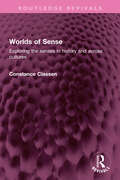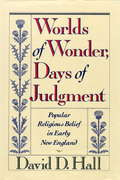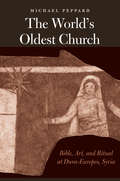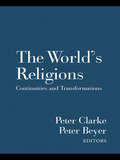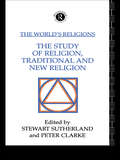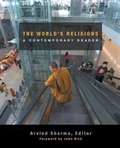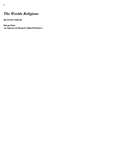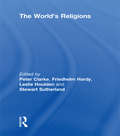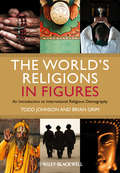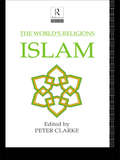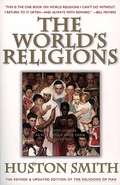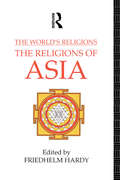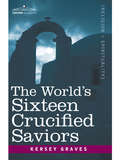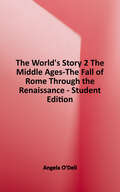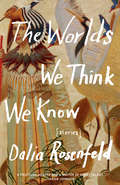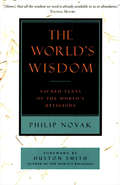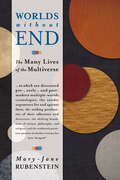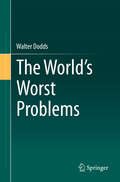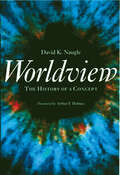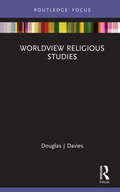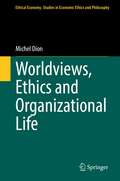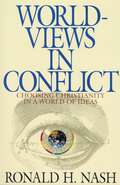- Table View
- List View
Worlds of Sense: Exploring the senses in history and across cultures (Routledge Revivals)
by Constance ClassenFirst published in 1993, Worlds of Sense is an exploration of the historical and cultural formation of the senses. As the author demonstrates, different cultures have strikingly different ways of ‘making sense’ of the world. In the modern urban West, we are accustomed to thinking in terms of visual models such as ‘world view,’ whereas the Ongee of the Andaman Islands, for example, live in a world ordered by smell and the Tzotzil of Mexico hold that temperature is the basic force of the cosmos. In a fascinating examination of the role of the senses in diverse societies and eras, Constance Classen shows the extent to which perception is shaped by and expressive of cultural values. This book will be of interest to students of cultural studies, sociology, anthropology, and philosophy.
Worlds Of Wonder, Days Of Judgment
by David D. HallThis book tells an extraordinary story of the people of early New England and their spiritual lives. It is about ordinary people--farmers, housewives, artisans, merchants, sailors, aspiring scholars--struggling to make sense of their time and place on earth. David Hall describes a world of religious consensus and resistance: a variety of conflicting beliefs and believers ranging from the committed core to outright dissenters. He reveals for the first time the many-layered complexity of colonial religious life, and the importance within it of traditions derived from those of the Old World. We see a religion of the laity that was to merge with the tide of democratic nationalism in the nineteenth century, and that remains with us today as the essence of Protestant America.
The World's Oldest Church
by Michael PeppardMichael Peppard provides a historical and theological reassessment of the oldest Christian building ever discovered, the third-century house-church at Dura-Europos. Contrary to commonly held assumptions about Christian initiation, Peppard contends that rituals here did not primarily embody notions of death and resurrection. Rather, he portrays the motifs of the church's wall paintings as those of empowerment, healing, marriage, and incarnation, while boldly reidentifying the figure of a woman formerly believed to be a repentant sinner as the Virgin Mary. This richly illustrated volume is a breakthrough work that enhances our understanding of early Christianity at the nexus of Bible, art, and ritual.
The World's Religions: Continuities and Transformations
by Peter B. ClarkeThis comprehensive volume focuses on the world's religions and the changes they have undergone as they become more global and diverse in form. It explores the religions of the world not only in the regions with which they have been historically associated, but also looks at the new cultural and religious contexts in which they are developing. It considers the role of migration in the spread of religions by examining the issues raised for modern societies by the increasing interaction of different religions. The volume also addresses such central questions as the dynamics of religious innovation which is evidenced in the rise and impact of new religious and new spirituality movements in every continent.
The World's Religions: The Study Of Religion, Traditional And New Religion (The\world's Religions Ser.)
by Peter Clarke Stewart SutherlandExamines the `primitive' (traditional) non -mainstream religion and also 20th century sects such as the Moonies and Scientology. Looks at the `nature' of religion - the general philosophical issues. Written by international specialists.
The World's Religions: A Contemporary Reader
by Arvind SharmaHistory is never contemporary, for the contemporary is perpetually slipping into history, but with some license one may refer to the immediate past as contemporary history. This point possesses some additional justification when the field to which it is applied is that of the world's religions because so much has happened in such a small time in the recent past, so far as this world's religions are concerned. To grasp this point one needs to realize that what may be called the "secular hypothesis" dominated the worldview not only of academia and the media but also the world of politicians and bureaucrats not that long ago. The belief was so widespread as to have been left virtually unarticulated, that religion as a factor in human affairs was either destined to oblivion, as the Communists would have us believe, or destined to retreat into the private realm, as liberal ideology, characterized by capitalism, would have us imagine. Not many cared about the world's religions at the turn of the century, when secularization, hand in hand with globalization, seemed to be proceeding apace, converting the world into both one market and one marketplace of ideas, promising homogeneity as a unifying force for humanity, destined to erode religious diversity as all of us became more like each other. The Iranian Revolution of 1979 could then be treated like a retrogressive hiccup of tradition in this forward march of modernity.
The World's Religions
by Huston SmithDescribes the similarities and differences between Hinduism, Buddhism, Confucianism, Taoism, Islam, Judaism, Christianity and primal religions.
The World's Religions
by Huston SmithThe World’s Religions, by beloved author and pioneering professor Huston Smith (Tales of Wonder), is the definitive classic for introducing the essential elements and teachings of the world's predominant faiths, including Hinduism, Buddhism, Confucianism, Taoism, Judaism, Christianity, Islam, as well as regional native traditions. <p><p>This revised and updated edition provides sympathetic descriptions of the various traditions, explaining how they work “from the inside,” which is a big reason why this cherished classic has sold more than two million copies since it first appeared in 1958.
The World's Religions: Continuities And Transformations (Routledge Companion Encyclopedias)
by Stewart Sutherland Leslie Houlden Peter Clarke Friedhelm Hardy* Gives an account of the history, the theological basis, the practice and the current state of the study of religion and religions throughout the world* Combines a clear and non-technical style of presentation with a structure and range of contributions which reflect the richness and complexity of religion itself, of the religions of the world and the study of religions* Comprehensive index, bibliographies and suggestions for further reading`Intriguing philosophical questions are raised about the nature of religion and the qualities needed for studying it.' - Times Higher Education Supplement`Excellent book ... remarkably successful, impressive as much for the sheer scale of the undertaking as for its consistent standard of analysis. It is a fine achievement which will serve both as a very suitable textbook for students and a reliable guide to the state of scholarship in the History and Study of Religions.' - Heythrop Journal
The World's Religions in Figures
by Todd M. JohnsonCreated by two of the field's leading experts, this unique introduction to international religious demography outlines the challenges in interpreting data on religious adherence, and presents a contemporary portrait of global religious belief. Offers the first comprehensive overview of the field of international religious demography - detailing what we know about religious adherents around the world, and how we know it Examines religious freedom and diversity, including agnostics and atheists, on a global scale, highlighting trends over the past 100 years and projecting estimates for the year 2050 Outlines the issues and challenges related to definitions, taxonomies, sources, analyses, and other techniques in interpreting data on religious adherence Considers data from religious communities, censuses, surveys, and scholarly research, along with several in-depth case studies on the global Muslim population, religion in China, and the religious demography of recently created Sudan and South Sudan Argues against the belief that the twentieth-century was a 'secular' period by putting forward new evidence to the contrary Provides resources for measuring both qualitatively and quantitatively important data on the world's religious situation in the twenty-first century
The World's Religions: Islam (The\world's Religions Ser.)
by Peter ClarkeThe theological and philosophical bases of the beliefs are clearly presented with their history, development, expression and everyday practice. It is written by international specialists in a scholarly but non-technical style.
The World's Religions, Revised and Updated: A Concise Introduction (Plus Ser.)
by Huston SmithHuston Smith's masterpiece explores the essential elements and teachings of the world's predominant faiths, including Hinduism, Buddhism, Confucianism, Taoism, Judaism, Christianity, Islam, and the native traditions of Australia, Africa, Oceania, and the Americas. Emphasizing the inner--rather than the institutional--dimension of these religions, Smith devotes special attention to Zen and Tibetan Buddhism, Sufism, and the teachings of Jesus. He convincingly conveys the unique appeal and gifts of each of the traditions and reveals their hold on the human heart and imagination.
The World's Religions: The Religions of Asia
by Friedhelm HardyFirst published in 1990. Routledge is an imprint of Taylor & Francis, an informa company.
The World's Sixteen Crucified Saviors: Christianity before Christ
by Kersey GravesKhrisna of India. Thammuz of Syria. Esus of the Celtic Druids. Mithra of Persia. Quexalcoati of Mexico. All were crucified gods, and all met their fates hundreds of years before Jesus appeared on the scene. In this foundational work of modern atheism, American spiritualist KERSEY GRAVES (1813-1883) breaks the Christ myth down into its component parts and ably demonstrates how the story of Jesus has its roots in the depths of antiquity. Here you'll read about the surprising prevalence throughout global folklore of: . the miraculous and immaculate conception of the gods . stars that point out the time and place of a savior's birth . angels, shepherds, and magi visiting an infant savior . the 25th of December as the universal birth date of gods . saviors who descend into Hell . and much more. This is essential reading for students of comparative mythology and modern freethinkers. Also available from Cosimo: Graves's The Biography of Satan and The Bible of Bible.
The World's Story 2 The Middle Ages-The Fall of Rome Through the Renaissance - Student Edition
by Angela O'DellAngela O’Dell’s World’s Story series uses the same fun style of her popular America’s Story series to teach junior high students about world history. Students will learn about everything from the fall of Rome to the Renaissance in a survey that covers Europe, Asia, Africa, and the Americas. Written from a strong Christian perspective, students will see God’s hand throughout history and learn about how this history is still relevant to their lives today.
The Worlds We Think We Know: Stories
by Dalia RosenfeldStories that follow the lives of Jewish characters from the Midwest to the Middle East and beyond: “A profound debut from a writer of great talent.” —Adam Johnson, New York Times–bestselling author of The Orphan Master’s SonThe characters of The Worlds We Think We Know are swept up by forces beyond their control: war, adulthood, family—and their own emotions, as powerful as the sandstorm that gusts through these stories. In Ohio, a college student cruelly enlists the help of the boy who loves her to attract the attention of her own crush. In Israel, a young American woman visits an uncommunicative Holocaust survivor and falls in love with a soldier. And from an unnamed Eastern European country, a woman haunts the husband who left her behind for a new life in New York City.The Worlds We Think We Know is a dazzling fiction debut—fiercely funny and entirely original.“Outstanding . . . Set in locales including present-day Jerusalem, the permafrost region of Russia and the streets of Manhattan, Rosenfeld’s best stories focus not only on loss, but on its aftermath: living in the presence of absence.” —Haaretz“Funny and poignant . . . The lush melancholy of this collection is bolstered by the characters’ deep intelligence and wit . . . Jewish history is shredded through with displacement, and many of Rosenfeld’s characters are caught in the position of a having a long cultural history and no sense of home.” —Electric Literature
The World's Wisdom
by Philip NovakA world Bible for our time from Buddhist, Hindu, Confucian, Taoist, Jewish, Christian, Islamic, and primal religion sources! In this perfect companion to Huston Smith's bestselling The World's Wisdom, Philip Novak distills the most powerful and elegant expressions of the wisdom of humankind. Authentic, poetic translations of key texts are coupled with insightful introductions and "grace notes."
Worlds without End: The Many Lives of the Multiverse
by Mary-Jane RubensteinA religion professor elucidates the theory of the multiverse, its history, and its reception in science, philosophy, religion, and literature.Multiverse cosmologies imagine our universe as just one of a vast number of others. Beginning with ancient Atomist and Stoic philosophies, Mary-Jane Rubenstein links contemporary models of the multiverse to their forerunners and explores the reasons for their recent appearance. One concerns the so-called fine-tuning of the universe: nature's constants are so delicately calibrated that it seems they have been set just right to allow life to emerge. For some thinkers, these "fine-tunings" are evidence of the existence of God; for others, however, and for most physicists, "God" is an insufficient scientific explanation. Hence the multiverse&’s allure: if all possible worlds exist somewhere, then like monkeys hammering out Shakespeare, one universe is bound to be suitable for life. Of course, this hypothesis replaces God with an equally baffling article of faith: the existence of universes beyond, before, or after our own, eternally generated yet forever inaccessible to observation or experiment. In their very efforts to sidestep metaphysics, theoretical physicists propose multiverse scenarios that collide with it and even produce counter-theological narratives. Far from invalidating multiverse hypotheses, Rubenstein argues, this interdisciplinary collision actually secures their scientific viability. We may therefore be witnessing a radical reconfiguration of physics, philosophy, and religion in the modern turn to the multiverse.&“Rubenstein&’s witty, thought-provoking history of philosophy and physics leaves one in awe of just how close Thomas Aquinas and American physicist Steven Weinberg are in spirit as they seek ultimate answers.&”—Publishers Weekly&“A fun, mind-stretching read, clear and enlightening.&”—San Francisco Book Review
The World's Worst Problems
by Walter DoddsThis book addresses the worst problems currently facing humanity and those that may pose future threats. The problems are explained and approached through a scientific lens, and categorized based on data involving global mortality, vulnerability, and threat level. The book presents indices of problem severity to compare relative intensity of current and potential crises. The approach avoids emotional argument using mainly empirical evidence to support the classification of relative problem severity. The author discusses multiple global problems and ranks them. He also explores specific solutions to each problem, links problems to human behavior from a social science perspective, considers international cooperation, and finally pathways to solutions.The book discusses confirmation bias and why this necessitates a scientific approach to tackle problems. The moral assumption that each person has the same rights to life and minimal suffering, and that the natural world has a right to exist, forms the basis of ranking problems based on death, suffering, and harm to the natural world. A focus is given to potential disasters such as asteroid collisions and super-volcanic eruptions, which are then presented in chapters that address specific contemporary global issues including disease, hunger, nuclear weapons and climate change. Furthermore the author then ranks the problems based on an index of problem severity, considering what other people think the worst problems are. The relative economic costs to solve each of these problems, individual behavior in the face of these problems, how people could work together internationally to combat them, and a general pathway toward solutions form the basis of the final chapters. This work will appeal to a wide range of readers, students considering how they can help the world, and scientists and policy makers interested in global problem solving.
Worldview: The History of a Concept
by David K. NaugleConceiving of Christianity as a "worldview" has been one of the most significant events in the church in the last 150 years. In this new book David Naugle provides the best discussion yet of the history and contemporary use of worldview as a totalizing approach to faith and life. This informative volume first locates the origin of worldview in the writings of Immanuel Kant and surveys the rapid proliferation of its use throughout the English-speaking world. Naugle then provides the first study ever undertaken of the insights of major Western philosophers on the subject of worldview and offers an original examination of the role this concept has played in the natural and social sciences. Finally, Naugle gives the concept biblical and theological grounding, exploring the unique ways that worldview has been used in the Evangelical, Orthodox, and Catholic traditions. This clear presentation of the concept of worldview will be valuable to a wide range of readers.
Worldview Religious Studies (Routledge Focus on Religion)
by Douglas J DaviesWorldview Religious Studies brings the study of religion, spirituality, secularism, and other mixed attitudes of life under the overarching scheme of worldview studies. This book introduces and defines worldviews more generally before establishing a framework specific to religious studies. The drive for meaning-making is explored through ritual-symbolic activities, ideas of ‘play’, and the power of emotions to transform simple ideas into values and beliefs that frame identity and signpost destiny. Identity and its sacralisation are discussed alongside gift/reciprocity theory in their relation to ideas of merit, karma, and salvation in Eastern and Western traditions. This theoretical background is used to introduce a new classification of worldviews - natural, scientific, ancestral, karmic, prophetic-sectarian, mystical, and ideological. Organised thematically by chapter, this book brings together familiar and unfamiliar authors, theories, and sources to challenge students and teachers of Religious Studies, Theology, and Ethics. It introduces worldview religious studies as a framework through which to re-think human endeavours to identify, cope and even transcend life’s flaws and perils.
Worldviews: A Comprehensive Approach to Knowing Self and Others
by John ValkThis book investigates the concept of worldview, in its numerous aspects, and how worldviews impact, shape, and influence individuals, communities, societies, and cultures. It explores various worldviews—religious, spiritual, and secular—using a comprehensive approach to highlight their breadth, depth, and scope. John Valk argues that everyone has a worldview, and that worldview is often shaped and influenced by individual circumstances and situations. While worldviews have similar structures to one another, they vary in content, including differences in metanarratives, teachings, ethics, and more. In the course of explaining how worldviews respond to life’s ultimate and existential challenges, the book poses ontological questions to highlight various (world)views on the nature of being and the human, and epistemological questions pertaining to sources of knowledge and certainty. Inviting readers to reflect on their own worldviews as they explore the worldviews of others, Valk also reveals how certain universal worldview beliefs are interpreted in particular contexts.
Worldviews Comparison
by Alex McfarlandExperience the convenience of having this amazing Bible Study Tool at your fingertips--wherever you go! Plus, you can read, search, enlarge, and print the pamphlet right off your computer.This comparison of worldviews helps you know what you believe and why. A worldview is the "big picture" view of the world, one that attempts to answer all the big questions of life: What is real? If there is a God, what is God's nature? What is a human being? How can we know what is right or wrong?This chart compares 8 worldviews:*Atheism - There is no God*Pantheism - God is all.*Pan-En-theism - God is in all*Deism - God is a distant creator*Finite God-ism - There is a God, but he is limited*Polytheism - There are many gods*Monotheism - There is only god*Biblical Christianity - There is only one Triune godQuestions compared:*Is there a God?*What is Real?*Where Did What's Real Come From?*What is a Human Being?*Are Humans Basically Good or Evil? How bad is the flaw?*Is it Possible to Know Anything at All?*How Do We Know What is Right and Wrong?*What is Truth?*What is Evil?*Where do laws come from?*What Happens After Death?*Can Miracles Happen?*What is the Meaning of Human History?*How Do We Get to Know God?Author Alex McFarland, M.A., is the president of Southern Evangelical Seminary in Charlotte, NC. Worldviews Comparison
Worldviews, Ethics and Organizational Life (Ethical Economy #60)
by Michel DionThis book provides an innovative way to revisit the depth and scope of our moral/post-moral worldviews, while undertaking an ontic reflection about organizational life. The ontic dimension of life refers to existing entities’ lived experiences. It has nothing to do with psychological and relational processes. The ontic level of analysis mirrors a philosophical outlook on organizational life. Unlike moral worldviews, post-moral worldviews oppose the existence of Truth-itself. Post-moral worldviews rather imply that dialogical relationships allow people to express their own truth-claims and welcome others’ truth-claims. The purpose of this book is to explain the philosophical implications of moral and post-moral worldviews and the way to move from a moral to a post-moral worldview. Moreover, this book explores the possibility to transcend the moral/post-moral dualism, through moral deliberation processes and a reinterpretation of the Presence of the Infinite in all dimensions of human life. This book could eventually help to better grasp the basic philosophical challenges behind ethical reflection about organizational issues.
Worldviews in Conflict: Choosing Christianity in the World of Ideas
by Ronald H. NashThis world is a battlefield in the arena of ideas. The prize is the heart and mind of humankind. In this book, Ronald Nash outlines the Christian way of looking at God, self, and the world. He holds that worldview up against the tests of reason, logic, and experience, particularly discussing the problems of evil and the alleged "nonsense" of the historic Christian doctrines and of Jesus' incarnation and resurrection. He finds the Christian worldview sound and urges Christians to equip themselves intellectually to defend the faith on that battlefield. He particularly hits the attractions to our generation of naturalism and the New Age movement, pointing out their weaknesses and pitfalls as well as those of older worldviews. "Christian theism," he writes, "is a system that commends itself to the whole person"; but he stresses that a great difference exists between "belief that" and "belief in."
